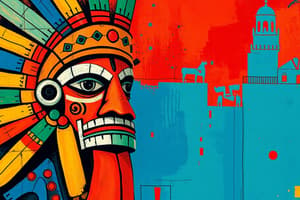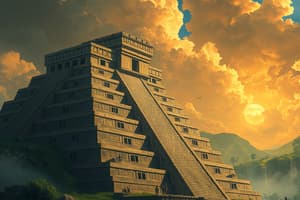Podcast
Questions and Answers
What was the primary region where the Aztecs lived?
What was the primary region where the Aztecs lived?
Mesoamerican region, primarily modern-day Mexico
What was the significance of the eagle, snake, and cactus image in Aztec legend?
What was the significance of the eagle, snake, and cactus image in Aztec legend?
It led the Mexica to build the city of Tenochtitlan on an island surrounded by Lake Texcoco.
What were some distinctive features of the city of Tenochtitlan?
What were some distinctive features of the city of Tenochtitlan?
Twin pyramids, a grand palace, busy markets, a botanical garden, zoos, and an aquarium.
What was the purpose of the levee constructed in Tenochtitlan?
What was the purpose of the levee constructed in Tenochtitlan?
What was the result of the complex technology and engineering required in Tenochtitlan?
What was the result of the complex technology and engineering required in Tenochtitlan?
What was the main difference between the education system of noble children and commoner children in the Aztec empire?
What was the main difference between the education system of noble children and commoner children in the Aztec empire?
What was the significance of the Aztec's creation of hot chocolate?
What was the significance of the Aztec's creation of hot chocolate?
What was the Aztec's belief regarding the sun and human sacrifice?
What was the Aztec's belief regarding the sun and human sacrifice?
What was the significance of the Toltec people to the Aztecs?
What was the significance of the Toltec people to the Aztecs?
What event marked the beginning of the end of the Aztec civilization?
What event marked the beginning of the end of the Aztec civilization?
Flashcards are hidden until you start studying
Study Notes
• The Aztecs lived in the Mesoamerican region, primarily modern-day Mexico, starting around 1325 CE, and their civilization emerged after the decline of the Olmec and Maya civilizations. • The Aztecs had a strong warrior culture and spread their influence widely throughout the Mesoamerican region, adopting influences from the groups they conquered. • According to Aztec legend, the Mexica, the ruling people of the Aztecs, saw a vision of an eagle on top of a prickly pear cactus, eating a snake, which led them to build the city of Tenochtitlan on an island surrounded by Lake Texcoco. • The image of the eagle, snake, and cactus appears on the flag of Mexico today, and Tenochtitlan became the most powerful city in Mesoamerica and one of the largest cities in the world. • The city featured twin pyramids, a grand palace, busy markets, a botanical garden, zoos, and an aquarium, showcasing impressive engineering technologies. • The city's unique location on a lake required innovative engineering solutions, including bridges with movable parts, canals, and plots of land for farming. • A levee was constructed to block saltwater and allow spring water into the lake, enabling crops to grow, and aqueducts brought fresh water into the city. • Today, Mexico City stands where Tenochtitlan once was, and the city's complex technology and engineering required a strict and complicated social hierarchy. • The upper class, or nobles, consisted of government, military, and religious leaders, who were entitled to receive goods, services, or labor from common people. • Nobles and rulers inherited their class from their parents, and only they were allowed to wear jewelry and decorated capes. • Commoners were farmers, craftsmen, merchants, and low-level priests, living in neighborhoods ruled by a nobleman and a council, with artisans and traveling merchants being wealthy and highest within this class. • The Aztecs also had serfs and slaves, who worked land owned by nobles and did not live in the calpulli, and people could become slaves as a form of punishment or to pay off debts. • Women held some leadership positions within the Aztec empire, managing guilds and markets, working as midwives and priestesses, but top administrative positions were reserved for men. • All Aztec children attended school, where they learned based on their gender and social class, with commoner young men learning to be warriors and boys beginning their training at 15. • Noble children and gifted commoner children attended schools starting around age 6, learning to become priests and government officials, while also receiving military training. • The Aztecs developed a solar calendar based on the Mayan calendar and shared many cultural practices with other Mesoamerican groups, including a love of ball games and chocolate. • The Aztecs created hot chocolate, a valuable drink made from roasted cocoa beans, corn, vanilla, chili, and water, which was considered more valuable than modern-day hot chocolate. • The Aztecs admired the Toltec people and claimed to be related to them, adopting their cultural practices and art, and writing about their history. • The Toltec people were revered throughout Mesoamerica for their art and culture, and the Aztecs saw them as the epitome of civilization and sophistication. • The Aztecs believed in a complex pantheon of gods, building pyramids and creating theater where people impersonated the gods, and thought that the gods controlled all natural events. • They believed that the gods had human-like feelings and behavior, and that the sun needed human sacrifice to rise every day, and that the gods created the world through the story of the Fifth Sun. • The Aztecs saw several bad omens during the reign of King Montezuma II in the early 1500s, which they believed signaled that something bad was going to happen. • In 1519, Spanish conquerors arrived in Mesoamerica, leading to the imprisonment of King Montezuma II and the eventual fall of the Aztec civilization.
Studying That Suits You
Use AI to generate personalized quizzes and flashcards to suit your learning preferences.




